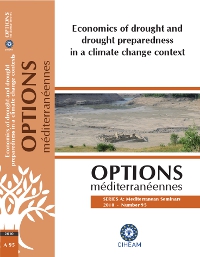| Article précédent | p. 301-305 | Article suivant |
Screening bread wheat genotypes for drought tolerance: Germination, radical growth and mean performance of yield and its components
Seed germination decreased as osmotic potential became more negative. Inhibition of seed germination was greatest under the lowest osmotic potential, -1.5 MPa. Cumulative germination after ten days ranged from 52.6 to 97.9 percent for the control compared to 27.4 to 69.8 percent at -1.5 MPa indicating more pronounced differences among genotypes at the lower osmotic potentials. Accordingly, ten bread wheat genotypes were selected and significantly varied for all traits tested under different irrigation treatments in each location. A reduction percentage for different studied traits under water stress treatments relative to control treatment was detected and susceptibility index (S) was also calculated for each genotype under severe water stress treatment. The superior lines numbers 27, 13, 15 and 5 had the highest grain yield/plant under severe treatment in both locations. The higher yielding capability of these genotypes obtained under drought stress may be primarily due to its higher yield potential under non stress conditions and maximize production of number of spikes/plant and number of grains/spike under water stress conditions. The main effect of irrigation treatments was not significant for susceptibility index (S) of grain yield/plant under both environments tested, indicating that S was not affected by increasing water stress intensity. S values ranged from 0.924 for G1 to 1.54 for the local check variety G10.
La germination des semences diminue à mesure que le potentiel osmotique devient plus négatif. L'inhibition de la germination des semences est plus grande dans le cadre d'un plus faible potentiel osmotique, - 1,5 MPa. La germination cumulée après dix jours varie de 52,6 pour cent à 97,9 pour cent pour le témoin contre 27,4 pour cent à 69,8 pour cent à -1,5 MPa, indiquant des différences plus marquées entre les génotypes aux potentiels osmotiques inférieurs. En conséquence, dix génotypes de blé tendre ont été sélectionnés, significativement différents pour tous les caractères testés sous différents traitements d'irrigation à chaque endroit . Un pourcentage de réduction pour différents caractères étudiés sous traitements de stress hydrique, par rapport au témoin sans traitement, a été détecté et l'indice de sensibilité a également été calculé pour chaque génotype sous traitement de stress hydrique sévère. Les lignes supérieures Nº 27, 13, 15 et 5 avaient le plus haut rendement en grains / plante sous traitements sévères dans les deux endroits. La capacité de rendement plus élevée de ces génotypes obtenus sous conditions de sécheresse peut être due principalement à leur potentiel de rendement plus élevé en conditions de non stress et à la maximisation de la production du nombre d'épis / plante et du nombre de grains / épi en conditions de stress hydrique. Le principal effet des traitements d'irrigation n'était pas significatif pour l'indice de sensibilité (S) du rendement en grains / plante sous les deux environnements testés, indiquant que (S) n'a pas été affectée par l'augmentation de la contrainte hydrique. Les valeurs de S vont de 0,924 pour G1 à 1,54 pour la variété locale testeur G10.
- [ Afficher ]
- [ Télécharger ]
- [ Exporter la citation ]
Vous pouvez télécharger la citation au format :
- [ Imprimer ]
-
Mots-clés
CROISSANCE, EGYPTE, GENOTYPE, GERMINATION, RENDEMENT, RESISTANCE A LA SECHERESSE, STRESS DU A LA SECHERESSE, TRITICUM AESTIVUMCiter cet article
Abd El Moneim D.A., Mohamed I.N., Belal A.H., Atta M.E. Screening bread wheat genotypes for drought tolerance: Germination, radical growth and mean performance of yield and its components. In : López-Francos A. (comp.), López-Francos A. (collab.). Economics of drought and drought preparedness in a climate change context. Zaragoza : CIHEAM / FAO / ICARDA / GDAR / CEIGRAM / MARM, 2010. p. 301-305. (Options Méditerranéennes : Série A. Séminaires Méditerranéens; n. 95). 2. International Conference on Drought Management, 2010/03/04-06, Istanbul (Turkey). http://om.ciheam.org/om/pdf/a95/00801360.pdf



